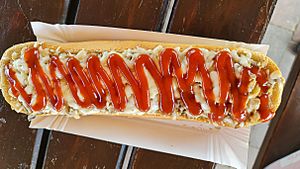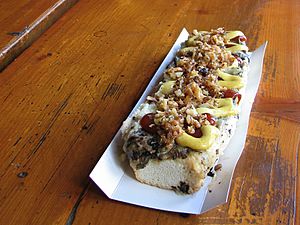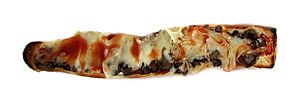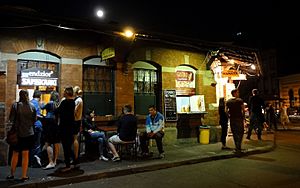Zapiekanka facts for kids

A typical zapiekanka served on a paper tray
|
|
| Alternative names | Polish pizza |
|---|---|
| Type | Street food |
| Place of origin | Poland |
| Associated national cuisine | Polish |
| Invented | 1970s |
| Serving temperature | Hot |
| Main ingredients | Baguette, button mushrooms, cheese |
| Ingredients generally used | Ketchup |
A zapiekanka (pronounced: zap-yeh-KAHN-kah), also called Polish pizza, is a tasty open-face sandwich. It's made from a long piece of bread, like a baguette. This bread is topped with cooked white mushrooms, cheese, and sometimes other yummy things like ham. People usually eat it hot with ketchup. It has been a popular street food in Poland since the 1970s.
Contents
What Does the Name "Zapiekanka" Mean?
The Polish word zapiekanka comes from the verb zapiekać. This means "to bake a dish so its ingredients mix together, and a crispy, browned crust forms on top." So, the name tells you how it's made! This word can also be used for other baked dishes, like casseroles.
How to Make and Enjoy Zapiekanka
A classic zapiekanka starts with half of a long white bread roll, cut lengthwise. It can be up to 50 centimeters (about 20 inches) long. The bread is covered with sliced, cooked white mushrooms and grated cheese. Then, it's toasted until the bread is crispy and the cheese is melted and bubbly.
Best Cheeses for Zapiekanka
For the best zapiekanka, people use hard, yellow cheeses that melt well. Good choices include Gouda, Edam, Emmental, Tilsit, or Cheddar. Sometimes, Polish smoked sheep milk cheese like oscypek is also used.
Serving Your Zapiekanka
A zapiekanka tastes best when it's hot. The most common topping is tomato ketchup, often drizzled generously over the melted cheese.
Different Kinds of Zapiekanka
You can find zapiekanki all over Poland, with many different toppings. Some frozen ones, heated in a microwave oven, might not taste as good. But many oven-baked zapiekanki offer lots of extra ingredients and sauces. This is why some people call them "Polish pizza".
Popular Zapiekanka Flavors
- "Diablo" has bacon, pickled cucumbers, and spicy sauce.
- "Gypsy" comes with ham and sweet and sour sauce.
- "Greek" includes olives and feta cheese.
- "Hawaiian" features pineapple and barbecue sauce.
You can often choose your own mix of toppings too! People also make zapiekanki at home, sometimes called "student's zapiekanka", using whatever ingredients they have.
The History of Zapiekanka
Zapiekanki first appeared on the streets of Polish towns in the 1970s. At that time, the government in Poland allowed small private businesses to open, especially for food. This led to many small family-owned food places, called mała gastronomia (which means "small gastronomy").
Zapiekanka During Food Shortages
These small food stands and food trucks became very popular, especially during times when food was harder to find. They sold zapiekanki along with other simple Polish dishes like kiełbasa sausage. They also offered American fast food like hot dogs, hamburgers, and French fries.
An American journalist named Anne Applebaum visited Poland in 1988. She described the zapiekanka back then as "a pizzalike substance." She said it was like a "poor relative" of Italian pizza, often a "mushy white sandwich roll" with "a few overcooked mushrooms" and "melted cheese and a squeeze of ketchup." But she still ate them because there wasn't much else available!
Zapiekanka Today
When Poland's economy changed in the 1990s, big fast food chains arrived. The demand for zapiekanki went down for a while. However, some of the original "small gastronomy" places survived. A few zapiekanka stands even became very famous, like those in Plac Nowy (New Square) in the Kazimierz district of Kraków. Today, zapiekanki are still a beloved and easy-to-find street food in Poland.
See also
 In Spanish: Zapiekanka para niños
In Spanish: Zapiekanka para niños




